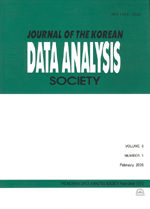분수브라운운동을 가정한 옵션가격결정모형의 유용성에 관한 연구
Empirical Performance of Option Pricing Model Which Assumes That A Underlying Asset Follows Fractional Brownian Motion
- 한국자료분석학회
- Journal of The Korean Data Analysis Society (JKDAS)
- Vol.17 No.1
-
2015.02229 - 241 (13 pages)
- 10

본 연구는 장기간의 국내지수옵션시장을 대상으로 모수의 추정방법과 예측기간, 옵션의 머니니스와 잔존기간 및 시장상황을 고려하여, 기하브라운운동의 마코브성을 분수브라운운동을 통해 수정한 Hu, Øksendal(2003) 모형의 옵션가격예측성과를 Black, Scholes(1973) 모형과 비교분석하였다. 옵션가격결정모형의 모수는 기초자산의 역사적정보, 옵션시장가격의 내재정보 그리고 역사적정보에 조건적인 내재정보를 이용하여 추정한다. 예측기간은 1거래일부터 9거래일까지이며, 기초자산의 변동성을 기준으로 전체분석기간을 구분하여 시장상황으로 인한 영향을 분석하였다. 분석결과, 외가격 콜옵션의 경우 예측기간에 상관없이 옵션시장가격으로부터 추정된 내재정보를 Hu, Øksendal(2003) 모형에 이용함으로써 Black, Scholes(1973) 모형보다 미래 옵션의 시장가격을 더 정확하게 예측할 수 있었다. 특히 예측의 상대적인 정확성은 예측기간이 길어지고 변동성이 높은 시장상황에서 더 증가하므로, 투자나 헤징, 제한된 차익거래를 수행하는 의사결정자들에게 Hu, Øksendal(2003) 모형은 더 유용하게 이용될 수 있을 것이다.
Because fractional Brownian motion is a generalization of Brownian motion and the Hurst s parameter in fractional Brownian motion allows us to model the statistical long-range dependence of the underlying log returns, we empirically test whether Hu, Øksendal (2003) s model can be a better alternative that extends Black, Scholes (1973) s model by considering parameter estimation methods, option s moneyness/maturity, forecasting periods and underlying market environments. Parameters of option pricing models are inferred by using underlying time-series historical information or (and) options cross-sectional implied information. The number of forecasting days is from 1 to 9 trading days. And forecasting errors are compared in periods of high volatility and low volatility. It is found that, regardless of forecasting periods, Hu, Øksendal (2003) s model shows the best performance in the case of out-of-the money call options. Especially, Hu, Øksendal (2003) s model is better in periods of high volatility and for a longer forecasting period.
1. 서론
2. 연구모형
3. 실증분석
4. 결론
References
(0)
(0)